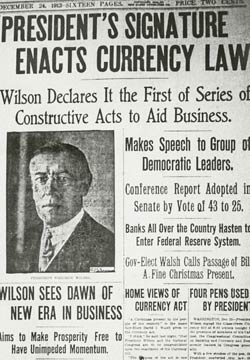Should We Abolish the Federal Reserve?
I know, this isn't directly related to buying Silver and Gold, but I thought it would be very interesting reading for my American readers.
CYA: SE:
******************************************
By , , • •
Millions of Americans assume the Fed acts in the nation's best interest and that our nation has always had a Fed.
In fact, neither is true according to Money Morning Chief Investment Strategist, Keith Fitz-Gerald.
"The American Fed, as it operates today, is an insult to anybody who believes in economic and political freedom. In an era of globally linked finance, the very concept of the Fed is an abomination."
You see, the Fed's original, century-old purpose no longer applies to modern day markets.
Far worse than that, the Fed's actions actually damage the U.S. economy…
Not many people realize this, but our nation hasn't always had a Fed. In fact, the Fed we have today is our third attempt at a central bank. The first two didn't work – "which ought to tell you something," Fitz-Gerald noted.
Further, the greatest economic growth in our nation's history happened between the Civil War and 1913 when there was no Fed and hard money policies supported industrialization. Between 1869 and 1879, for example, real GDP grew at 6.8% a year. Compare that to the anemic 1.5%-2% we have today after spending trillions.
But back to the Fed as we know it today…
Its original purpose was simple: To prevent banking failures.
 At
the time, the United States had just gone through the vicious bank
panic of 1907. That crisis was significant because it saw the failure of
Knickerbocker Trust (one of the largest banks in the U.S. at the time),
which sought – but failed – to receive financial support from its
peers. Unable to obtain liquidity from any source, Knickerbocker Trust
collapsed.
At
the time, the United States had just gone through the vicious bank
panic of 1907. That crisis was significant because it saw the failure of
Knickerbocker Trust (one of the largest banks in the U.S. at the time),
which sought – but failed – to receive financial support from its
peers. Unable to obtain liquidity from any source, Knickerbocker Trust
collapsed.
This affected public psychology deeply because Knickerbocker's peers not only failed to rescue Knickerbocker, but also suspended payments to each other. The effect boomeranged through the system and came to roost at the retail level when the public figured out they couldn't access their money.
Bank runs and closures became the norm. The New York Stock Exchange fell 50% before financier J.P. Morgan famously locked banking executives in his personal library and formulated a liquidity injection that ultimately calmed everything down.
Loath to waste a good crisis, U.S. lawmakers stepped in and agitated for centralized banking.
And so the U.S. Federal Reserve was born under the guise of a politically independent institution that would stabilize the financial system, protect the monetary supply against inflation, and maintain credit as needed. The Fed could do this by injecting stimulus when the economy flagged and withdrawing it when things were overheated.
"The Fed was viewed as giving elasticity to the dollar which would, in turn, establish more effective control over the banking system," Fitz-Gerald said. "The Comptroller of the Currency observed that the Fed would supply a circulating medium that is 'absolutely safe.' What irony."
You need only take a look at the Fed's track record today to see the damage it has wrought.
"Getting rid of the Federal Reserve is no longer a fringe, lunatic theory," Fitz-Gerald said. "In reality, there are very real reasons to abolish the Fed…"
According to the U.S. Census Bureau, the median income of male workers in 2010 was $32,137 while the median income of male workers in 1968 was $5,980. On the surface this looks good. It's a 437.4% increase over 42 years – or an average income gain of 10.41% a year, over the same time period.
However, if you run the numbers the other way, using 2010 dollars, this very different picture emerges…
 Median earning male workers actually have less purchasing power today than they did 42 years ago ($32,844 vs. $32,137).
Median earning male workers actually have less purchasing power today than they did 42 years ago ($32,844 vs. $32,137).
Fitz-Gerald points out that every 1913 dollar is now worth $0.04. Goods and services that cost a dollar back then now will set you back $21.
Putting this in terms that really hit home, Fitz-Gerald observes that, "Every year you have a paycheck that doesn't go up, you're actually getting a pay cut."
Where's the stability in that?
"That's your Federal Reserve at work. It's robbing America by gradually sucking the life out of the financial system. Over time, it will cause the system to collapse – just ask anybody in the former Soviet Union. They had a 'Fed,' and no Soviet bank ever failed per se. However, the state eventually took so much wealth from the people that the entire system broke."
In November 2008 under former chair Ben Bernanke, the Fed began printing money to presumably create economic value (a policy called "quantitative easing"). It bought $4.5 trillion in assets until QE was halted in October 2014.
"QE eviscerated the dollar. Bernanke believed printing money was the same thing as raising prices by managing inflation," Fitz-Gerald said. "In fact, inflation is actually defined as the artificial increase in the supply of money and credit. It's a tax by any other name. So what Bernanke and the Fed really did was artificially tax the American public by debasing its currency and force millions to take a pay cut at the same time."
While the modern-day Fed plays at devaluing the dollar, its original purpose as a liquidity failsafe has become useless in the wake of derivatives…
CYA: SE:
******************************************
By , , • •
Millions of Americans assume the Fed acts in the nation's best interest and that our nation has always had a Fed.
In fact, neither is true according to Money Morning Chief Investment Strategist, Keith Fitz-Gerald.
"The American Fed, as it operates today, is an insult to anybody who believes in economic and political freedom. In an era of globally linked finance, the very concept of the Fed is an abomination."
You see, the Fed's original, century-old purpose no longer applies to modern day markets.
Far worse than that, the Fed's actions actually damage the U.S. economy…
Federal Reserve History 101
To understand how dangerous the Federal Reserve is today, we have to look closer and how it started…Not many people realize this, but our nation hasn't always had a Fed. In fact, the Fed we have today is our third attempt at a central bank. The first two didn't work – "which ought to tell you something," Fitz-Gerald noted.
Further, the greatest economic growth in our nation's history happened between the Civil War and 1913 when there was no Fed and hard money policies supported industrialization. Between 1869 and 1879, for example, real GDP grew at 6.8% a year. Compare that to the anemic 1.5%-2% we have today after spending trillions.
But back to the Fed as we know it today…
Its original purpose was simple: To prevent banking failures.
 At
the time, the United States had just gone through the vicious bank
panic of 1907. That crisis was significant because it saw the failure of
Knickerbocker Trust (one of the largest banks in the U.S. at the time),
which sought – but failed – to receive financial support from its
peers. Unable to obtain liquidity from any source, Knickerbocker Trust
collapsed.
At
the time, the United States had just gone through the vicious bank
panic of 1907. That crisis was significant because it saw the failure of
Knickerbocker Trust (one of the largest banks in the U.S. at the time),
which sought – but failed – to receive financial support from its
peers. Unable to obtain liquidity from any source, Knickerbocker Trust
collapsed.This affected public psychology deeply because Knickerbocker's peers not only failed to rescue Knickerbocker, but also suspended payments to each other. The effect boomeranged through the system and came to roost at the retail level when the public figured out they couldn't access their money.
Bank runs and closures became the norm. The New York Stock Exchange fell 50% before financier J.P. Morgan famously locked banking executives in his personal library and formulated a liquidity injection that ultimately calmed everything down.
Loath to waste a good crisis, U.S. lawmakers stepped in and agitated for centralized banking.
And so the U.S. Federal Reserve was born under the guise of a politically independent institution that would stabilize the financial system, protect the monetary supply against inflation, and maintain credit as needed. The Fed could do this by injecting stimulus when the economy flagged and withdrawing it when things were overheated.
"The Fed was viewed as giving elasticity to the dollar which would, in turn, establish more effective control over the banking system," Fitz-Gerald said. "The Comptroller of the Currency observed that the Fed would supply a circulating medium that is 'absolutely safe.' What irony."
You need only take a look at the Fed's track record today to see the damage it has wrought.
"Getting rid of the Federal Reserve is no longer a fringe, lunatic theory," Fitz-Gerald said. "In reality, there are very real reasons to abolish the Fed…"
Why We Should Abolish the Fed: What It Has Done to the U.S. Dollar
The Fed has devalued the U.S. dollar.According to the U.S. Census Bureau, the median income of male workers in 2010 was $32,137 while the median income of male workers in 1968 was $5,980. On the surface this looks good. It's a 437.4% increase over 42 years – or an average income gain of 10.41% a year, over the same time period.
However, if you run the numbers the other way, using 2010 dollars, this very different picture emerges…
 Median earning male workers actually have less purchasing power today than they did 42 years ago ($32,844 vs. $32,137).
Median earning male workers actually have less purchasing power today than they did 42 years ago ($32,844 vs. $32,137).Fitz-Gerald points out that every 1913 dollar is now worth $0.04. Goods and services that cost a dollar back then now will set you back $21.
Putting this in terms that really hit home, Fitz-Gerald observes that, "Every year you have a paycheck that doesn't go up, you're actually getting a pay cut."
Where's the stability in that?
"That's your Federal Reserve at work. It's robbing America by gradually sucking the life out of the financial system. Over time, it will cause the system to collapse – just ask anybody in the former Soviet Union. They had a 'Fed,' and no Soviet bank ever failed per se. However, the state eventually took so much wealth from the people that the entire system broke."
In November 2008 under former chair Ben Bernanke, the Fed began printing money to presumably create economic value (a policy called "quantitative easing"). It bought $4.5 trillion in assets until QE was halted in October 2014.
"QE eviscerated the dollar. Bernanke believed printing money was the same thing as raising prices by managing inflation," Fitz-Gerald said. "In fact, inflation is actually defined as the artificial increase in the supply of money and credit. It's a tax by any other name. So what Bernanke and the Fed really did was artificially tax the American public by debasing its currency and force millions to take a pay cut at the same time."
While the modern-day Fed plays at devaluing the dollar, its original purpose as a liquidity failsafe has become useless in the wake of derivatives…
Comments
Post a Comment